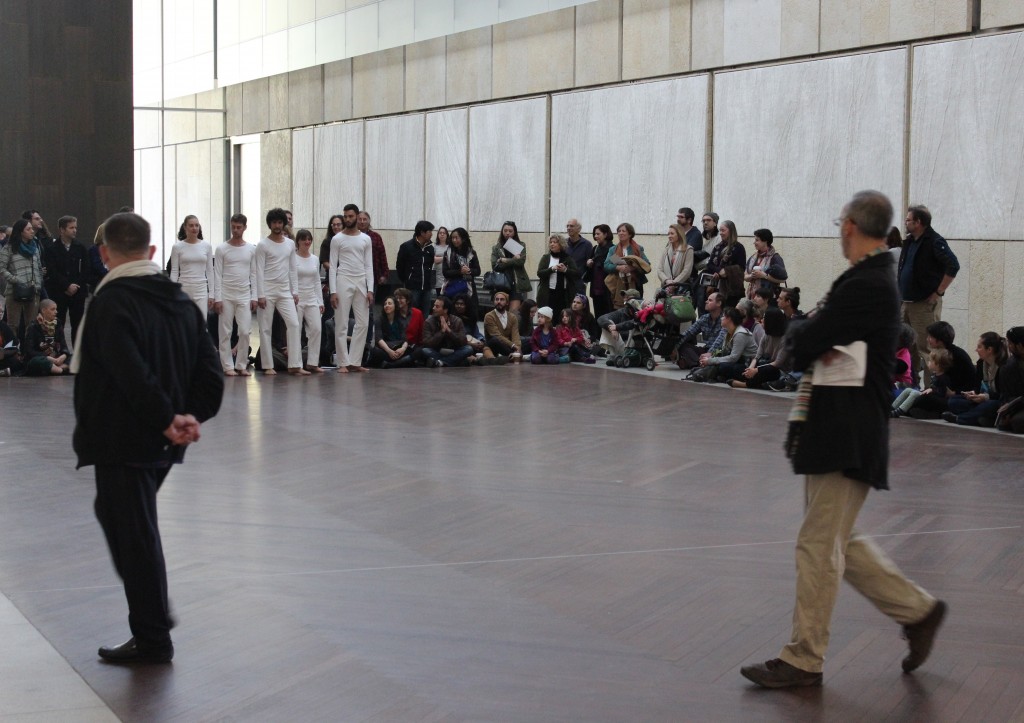This essay was originally printed in the program notes for the Early Works performance by Trisha Brown Dance Company at the Barnes Foundation, October 18, 2015, part of the Trisha Brown: In the New Body yearlong festival.

Before the feeling of the dance ever leaves you, you stop and look at the space around the dancers’ bodies. You notice areas of the Barnes in ways you did not perceive before. The dances were fluid and minimal—and yet, they held your gaze completely, made you aware of where you were standing, and perhaps even, how you were standing there; this is the gift of Trisha Brown’s choreography. You might walk outside and feel that everything is both completely the same and completely different than it was before. You might imagine how your body is relating to the space around you, to the sides of the building, to the objects in your path, and this is so: dance is both no more and no less than that. Brown said, “I have limbs, and I know them well; they are directly plugged into my imagination, and this is precisely what I need.”[i]
Imagine for a moment that you are a dancer. With the body you have, whether you’ve been trained in any way or you haven’t, you are a dancer and your body is your material. Imagine that you are an artist and you have precisely what you need to make your art. How will you set out to make that art? What’s the first action you will take with your body? What if you encounter someone whose body, like yours, is an artistic tool? What will you do with that person?
Maybe you’ll lean against each other shoulder-to-shoulder, maybe you’ll stand across from one another and rest sticks on your arms, maybe you’ll push up against that person’s back while twisting your wrists up over your head. The possibilities are endless, and you’ve only just started. But if this experiment is going to be successful, you need to develop a language for what you are doing so that you can work together, so that your individual bodies can work as if they are one—one with one another, one with objects, and one with the surfaces on which you move. As you develop this language, you will need to practice many times, you will need to refine your communication, and you will start to see new connections and relationships forming. Maybe this will make you want to become a choreographer.
The legacy of the 1960s Judson Dance Theater of which Trisha Brown, as well as Yvonne Rainer, Steve Paxton, Lucinda Childs, Carolee Schneemann, Donald Judd, Robert Morris, Robert Rauschenberg, and others were part, provided such an impulse. The artistic process was democratized: if you could listen, look, touch, move, or talk, you already had the necessary skills to initiate art making. The method with which you applied these skills would become your artistic process. This was the historic turn of the post-modern era, when art was taken down from its modernist pedestal and placed in the hands of the people.
In the discipline of dance, the quality of the performer’s presence started to become of equal value to that of virtuosity decades prior. Brown referred to this quality as a person’s person, saying, “What makes performing rewarding is when all of a person’s person has arrived at the same moment. Feeling is present, physical skill, and luck. It evinces a very special kind of humanity in the dancers. They inhabit themselves and the dancing very fully, with all the levels of their person brought into play.”[ii]
Brown’s desire to create a form of choreography through which the entirety of the dancer is meant to be seen marked a revolutionary turn in the very meaning of performance. Learning a dance included the cultivation of not only what was to be performed, but also and equally, how each performer would embody what was to be performed. Her Early Works are exemplary of this value – each dancer’s humanity is embedded within the formal structure of the dance.
This choreography has a place for you. As a viewer, you can find your own unique sense of arrival along with it. There is time and space enough for you to get there, to become fully present with what you are seeing so that you can acknowledge yourself as a whole person viewing other people. It is both that simple and that real.
[i] Trisha Brown quoted in “The Power of Inner Poetics” by Isabelle Ginot in Focus on Trisha Brown Ballett international/Tanz aktuell [English ed.] Feb. 1997
[ii] Trisha Brown quoted in “Trisha Brown: All of the Person’s Person Arriving,” by Marianne Goldberg, The Drama Review, MIT Press, Summer 1986
Marissa Perel is an artist, writer, and independent curator based in New York. In her line of inquiry, Perel asks, “How do we move across space and time with respect to our collected histories?” Her essays, reviews, experimental prose, and interviews engage this question at the convergence of the fields of contemporary art and performance. She originated the column “Gimme Shelter: Performance Now” for Art21 Magazine and edited Critical Correspondence, the on-line dance and performance journal of Movement Research. She also pursues this question in her curatorial work, seeking to bring visibility to a multitude of forms and discourses. She has curated performances, panels, and talks at such venues as the New Museum, New York, New York Live Arts, and at the Aux Performance Space at Vox Populi gallery, Philadelphia, where she was the inaugural Curatorial Fellow. She currently serves as Lecturer at the Low-Residency M.F.A program of the School of the Art Institute of Chicago.
Photo by: Josh McIlvain
